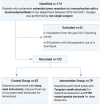Blood-saving dissection with monopolar tungsten needle electrodes and Teflon-coated spatula electrodes in tumor orthopedics
- PMID: 37188890
- PMCID: PMC10185722
- DOI: 10.1186/s10195-023-00704-8
Blood-saving dissection with monopolar tungsten needle electrodes and Teflon-coated spatula electrodes in tumor orthopedics
Abstract
Introduction: Resection of musculoskeletal tumors and reconstruction with tumor endoprostheses often results in blood loss requiring transfusion of blood products. We assessed the blood-saving potential of using monopolar tungsten needle electrodes and polytetrafluoroethylene (PTFE)-coated spatula electrodes (intervention) compared with conventional dissection with sharp instruments and coagulation with uncoated steel electrodes (control).
Methods: We retrospectively analyzed data of 132 patients (79 interventions, 53 controls) undergoing surgery by one single experienced surgeon in our tertiary referral center between 2012 and 2021.
Results: Intraoperative blood loss in the intervention group was reduced by 29% [median (IQR): 700 (400-1200) vs 500 (200-700) ml; p = 0.0043]. Postoperative wound drainage decreased by 41% [median (IQR): 1230 (668-2041) vs 730 (450-1354) ml; p = 0.0080]. Additionally, patients in need of PRBCs during surgery declined from 43% to 15% (23/53 vs 12/79; p = 0.0005), while the transfusion rate after surgery did not change notably. The number of patients in need of revision surgery due to wound healing disorders was low in both groups (control group: 4/53 vs intervention group: 4/79). Only one patient in the control group and two patients in the intervention group underwent revision surgery due to hemorrhage. Baseline characteristics were similar between groups (sex, Charlson Comorbidity score, tumor entity).
Conclusion: Dissection with tungsten needle electrodes and PTFE-coated spatula electrodes appears an effective surgical blood-saving measure without increased risk of wound healing disorders.
Level of evidence: III, retrospective comparative study.
Clinical trial registration: The study was registered at ClinicalTrials.gov. Identifier: NCT05164809.
Keywords: Blood loss; Electrosurgery; Patient blood management; Tumor endoprosthesis; Tumor orthopedics.
© 2023. The Author(s).
Conflict of interest statement
The authors declare that they have no competing interests.
Figures




References
MeSH terms
Substances
Associated data
LinkOut - more resources
Full Text Sources
Medical
Research Materials

